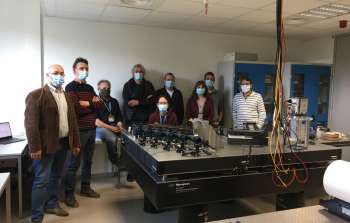sci21026 — Announcement
CHARA from VEGA to SPICA
March 15, 2021
19 December 2020 marked the end of VEGA—a visible-red beam combiner operated at the CHARA ARRAY on Mt Wilson. VEGA’s history began in May 2005 with the first email exchanges between Georgia State/CHARA, the Observatoire de la Côte d’Azur, and six other collaborating organizations. In August 2007, eight boxes weighing about 1200 kg were sent to Mt. Wilson, and after three weeks of integration the first fringes were obtained in September 2007. The next steps were 3-telescope operation in October 2008, followed by remote operation in summer 2009. Simultaneous VEGA operation with the CLIMB infrared beam combiner was initiated in May 2010, and finally the first 4-telescope fringes were obtained in October 2010 with the MIRC infrared combiner. Upgraded detectors and group delay tracking were implemented in 2012.
While in operation, VEGA measured stellar angular diameters down to 0.2 milliarcseconds, with concurrent spectral resolution up to 30,000—performance that remains unmatched by any other facility. VEGA excelled in measuring fundamental parameters of stars and in the study of stellar environments. Nearly 50 papers have been published and more are in preparation.
CHARA/VEGA was a fantastic scientific adventure for the scientists, engineers, and students that participated in its development and scientific operation over 15+ years.
Happily, we are able to announce that spectro-interferometry in the visible will soon return to Mt. Wilson. Later this year, the consortium will undertake installation of the beam combiner SPICA (Stellar Parameters and Images with a Cophased Array), which will implement recent and ongoing advances in adaptive optics, integrated optics, detectors, and CHARA performance. It will feature 6-telescope operation with near-infrared fringe tracking, and a capability for stellar surface imaging. The SPICA program is optimized for a survey of about 1000 stars, with scientific emphasis on exoplanet hosts, asteroseismology, surface brightness-color relations (for the photometric determination of effective temperatures), and distance scale.
We remind our readers that GSU and the CHARA collaborators support open access via the NOIRLab TAC. Stay tuned in the coming months for updates on SPICA and open access to the CHARA Array.
Contacts
Denis Mourard
Obs Cote d’Azur
VEGA, SPICA and CHARA collaborations
Steve Ridgway
NOIRLab
VEGA, SPICA and CHARA collaborations
About the Announcement
| Id: |
ID
sci21026
|
